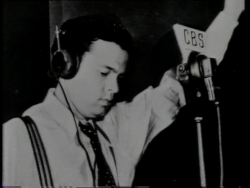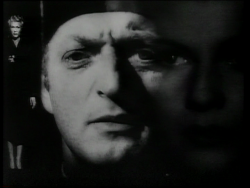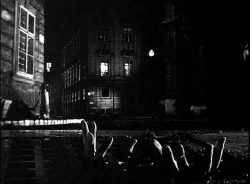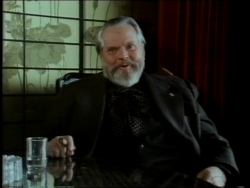by NEIL SINYARD
 “It’s like meeting God without dying,” said Dorothy Parker on first encountering Orson Welles. Still in his early twenties, Welles’s fame had preceded him: the boy wonder who could read by the age of two; who could quote chunks of King Lear by the time he was seven; who had written a treatise on Nietzsche and published a best-selling book on Shakespeare before he was out of his teens. A voodoo version of Macbeth and an anti-Fascist modern-dress Julius Caesar had established his stage reputation as a stupendously original director. His sensational radio broadcast of The War of the Worlds on Halloween night in 1938 had been powerful enough to provoke mass hysteria on a scale unprecedented for the modern media, either before or since. When at the age of 25, he produced, directed, starred in and co-wrote his debut feature Citizen Kane and it turned out to have the artistry and authority of an authentic film ‘auteur’ before the term had even been invented, there seemed only one possible way Welles’s career could go: down.
“It’s like meeting God without dying,” said Dorothy Parker on first encountering Orson Welles. Still in his early twenties, Welles’s fame had preceded him: the boy wonder who could read by the age of two; who could quote chunks of King Lear by the time he was seven; who had written a treatise on Nietzsche and published a best-selling book on Shakespeare before he was out of his teens. A voodoo version of Macbeth and an anti-Fascist modern-dress Julius Caesar had established his stage reputation as a stupendously original director. His sensational radio broadcast of The War of the Worlds on Halloween night in 1938 had been powerful enough to provoke mass hysteria on a scale unprecedented for the modern media, either before or since. When at the age of 25, he produced, directed, starred in and co-wrote his debut feature Citizen Kane and it turned out to have the artistry and authority of an authentic film ‘auteur’ before the term had even been invented, there seemed only one possible way Welles’s career could go: down.
When he was asked if he knew at the time he was making an important film, Welles replied with the swagger of the young Kane himself: “I never doubted it for a single instant”. Time has proved him right: Citizen Kane remains the Great American Film against which all contenders must be measured. Yet one cannot forget how closely Welles’s audacity courted catastrophe. In constructing a character portrait so close to the public and private life of the ruthless newspaper tycoon William Randolph Hearst who angrily tried to suppress the film, he came very close to making a masterpiece that would never be shown. Moreover, although the film radiates with the youth and precocious talents of its flamboyant collaborators, most of whom were new to the cinema, it also aches with the central character’s sense of frustrated achievement. It is a film of echo and shadow dominated by a gigantic but hollow man whose life trails into a shadow of what it might have become. Kane is always making promises, but they remain unfulfilled, like his own promise. It was as if Welles was tempting Providence, making a prophetic film of his own possible development. By a curious coincidence both Kane and Welles were to die the same age.
 It would be simplistic to view Welles’s subsequent career in terms of decline or anti-climax: there were great things still in store. Nevertheless, Kane was to prove an all-but-impossible act to follow. It was to be the first and last film in which he had total control. For nearly every subsequent film, there are at least two versions – the one that Welles wishes to make, and the one that was actually released. The Magnificent Ambersons (1942) was the film in which its hero and its director get their “come-uppance”: its reduction from 131 minutes to 88 by a panicky RKO after hostile previews remains one of the most appalling acts of vandalism in screen history. Because of various privations, Macbeth (1948) had to be shot in three weeks; because of different privations, Othello (1952) took three years. In spite of a 58-page memo by Welles defending his conception, Touch of Evil (1958) was cut and re-edited by Universal studios on its initial release. His career was to have more than its fair share of disappointments as cherished projects came to nothing, leaving him at times looking a bit like Kane in Xanudu: a king in unwilling exile in a kingdom of his own devising. Equally, though, he was still able to create some of the most dazzling moments in all cinema: the Amberson ball near the beginning of The Magnificent Ambersons, their world seen in all its splendour before the decline; the Hall of Mirrors finale in The Lady from Shanghai (1947), piling layer upon layer of visual deception; the astounding opening tracking shot of Touch of Evil, to show how everything is interconnected and being sucked into the main path of the narrative; the breathtaking but brutal spectacle of the Battle of Shrewsbury in Chimes at Midnight (1966), which signals the end of Merrie England. These are all caught in that unmistakable virtuoso camera-style of his that he said “describes that sense of vertigo, uncertainty, lack of stability, that melange of movement and tension that is our universe.”
It would be simplistic to view Welles’s subsequent career in terms of decline or anti-climax: there were great things still in store. Nevertheless, Kane was to prove an all-but-impossible act to follow. It was to be the first and last film in which he had total control. For nearly every subsequent film, there are at least two versions – the one that Welles wishes to make, and the one that was actually released. The Magnificent Ambersons (1942) was the film in which its hero and its director get their “come-uppance”: its reduction from 131 minutes to 88 by a panicky RKO after hostile previews remains one of the most appalling acts of vandalism in screen history. Because of various privations, Macbeth (1948) had to be shot in three weeks; because of different privations, Othello (1952) took three years. In spite of a 58-page memo by Welles defending his conception, Touch of Evil (1958) was cut and re-edited by Universal studios on its initial release. His career was to have more than its fair share of disappointments as cherished projects came to nothing, leaving him at times looking a bit like Kane in Xanudu: a king in unwilling exile in a kingdom of his own devising. Equally, though, he was still able to create some of the most dazzling moments in all cinema: the Amberson ball near the beginning of The Magnificent Ambersons, their world seen in all its splendour before the decline; the Hall of Mirrors finale in The Lady from Shanghai (1947), piling layer upon layer of visual deception; the astounding opening tracking shot of Touch of Evil, to show how everything is interconnected and being sucked into the main path of the narrative; the breathtaking but brutal spectacle of the Battle of Shrewsbury in Chimes at Midnight (1966), which signals the end of Merrie England. These are all caught in that unmistakable virtuoso camera-style of his that he said “describes that sense of vertigo, uncertainty, lack of stability, that melange of movement and tension that is our universe.”
Welles’s style reflected his world-view: it was impossible to separate one from the other. He was fascinated by two main character types: the innocent who has his eyes opened to the guilty world around him; and the egomaniac who wants to dominate that world. He anatomised the corrupting effects of power. The situation that aroused his strongest emotion was the act of personal betrayal, occurring between men who had seemed the best of friends or closest of confidantes: Kane and Leland, Harry Lime and Holly (The Third Man (1949)), Othello and Iago, Quinlan and Menzies (Touch of Evil), Falstaff and Prince Hal (Chimes at Midnight). “Betrayal is the big thing with me,” Welles told Peter Bogdanovich, “it’s almost a prime sin”. The theme resonated with him because he saw himself as the victim of many such betrayals in his own life. The critic Penelope Houston memorably described him as “the man the cinema has on its conscience”. In his obituary on Welles, director John Huston (who was playing the leading role in one of Welles’s numerous unfinished projects, The Other Side of the Wind) declared: “What a shame – and I mean that literally – that one of the finest talents motion pictures has ever had was rejected out of hand.”
 Yet to what extent was it the industry’s fault that, in Janet Leigh’s phrase, “his genius was not more fully used”? Was the betrayal in some way self-inflicted? Was there an element of playing the martyr almost as alibi for the possibility of artistic failure? Here was a man with gargantuan gifts – probably the most all-round talented artist the cinema has ever seen – who somehow, in some way, let it slip through his fingers: one even thinks subliminally of Harry Lime poking his fingers through the grating in The Third Man in a vain bid for freedom. Failure in Welles almost seems willed sometimes: the films returning obsessively to the theme of decline and fall, and his most memorable characters sinking as low as it is possible for man to go: Harry Lime dying in a sewer, Quinlan perishing in effluent.
Yet to what extent was it the industry’s fault that, in Janet Leigh’s phrase, “his genius was not more fully used”? Was the betrayal in some way self-inflicted? Was there an element of playing the martyr almost as alibi for the possibility of artistic failure? Here was a man with gargantuan gifts – probably the most all-round talented artist the cinema has ever seen – who somehow, in some way, let it slip through his fingers: one even thinks subliminally of Harry Lime poking his fingers through the grating in The Third Man in a vain bid for freedom. Failure in Welles almost seems willed sometimes: the films returning obsessively to the theme of decline and fall, and his most memorable characters sinking as low as it is possible for man to go: Harry Lime dying in a sewer, Quinlan perishing in effluent.
 Welles was a fascinating and charismatic magician of the cinema, even as he metamorphosed from the Kane of his youth to the Falstaff of his later years: a crown prince who had become something of a court-jester. Even as one is dazzled by his direction, one should not underestimate Welles’s greatness as an actor, one who, in Derek Jarman’s admiring estimation, “could punch holes in the screen”. Yet even here how typical it is that his most memorable screen incarnation, Harry Lime occupies only about eight minutes of the film’s length and that his greatest moment on screen was a spur-of-the moment improvisation: his impromptu, off-the cuff speech on behalf of Lime (perfectly in character and delivered with matchless irony and breath control) about the Renaissance, the Swiss and the cuckoo-clock. As with Charles Foster Kane, so with Welles: you are left with a sense of sadness and waste. Yet, with Citizen Kane, you are left with a sense of awe at the creator behind it. Also, like the reporter Thompson in Citizen Kane, who has investigated the character but misses the key to the puzzle, you are tantalised by a mystery. The magnificence of Welles is as incontestable as that of the Ambersons but it is an incomplete magnificence, fragments more than monuments: why? Is the clue to this incompleteness professional, artistic or biographical? Might there be a “Rosebud” in Welles’s life? As Kane’s most faithful friend, Bernstein (and how curious it is that he has the same name as Welles’s guardian as a young man) says: “That Rosebud you’re trying to find out about… Maybe that was something he lost…”
Welles was a fascinating and charismatic magician of the cinema, even as he metamorphosed from the Kane of his youth to the Falstaff of his later years: a crown prince who had become something of a court-jester. Even as one is dazzled by his direction, one should not underestimate Welles’s greatness as an actor, one who, in Derek Jarman’s admiring estimation, “could punch holes in the screen”. Yet even here how typical it is that his most memorable screen incarnation, Harry Lime occupies only about eight minutes of the film’s length and that his greatest moment on screen was a spur-of-the moment improvisation: his impromptu, off-the cuff speech on behalf of Lime (perfectly in character and delivered with matchless irony and breath control) about the Renaissance, the Swiss and the cuckoo-clock. As with Charles Foster Kane, so with Welles: you are left with a sense of sadness and waste. Yet, with Citizen Kane, you are left with a sense of awe at the creator behind it. Also, like the reporter Thompson in Citizen Kane, who has investigated the character but misses the key to the puzzle, you are tantalised by a mystery. The magnificence of Welles is as incontestable as that of the Ambersons but it is an incomplete magnificence, fragments more than monuments: why? Is the clue to this incompleteness professional, artistic or biographical? Might there be a “Rosebud” in Welles’s life? As Kane’s most faithful friend, Bernstein (and how curious it is that he has the same name as Welles’s guardian as a young man) says: “That Rosebud you’re trying to find out about… Maybe that was something he lost…”
Now go to: The Magnificent Ambersons
